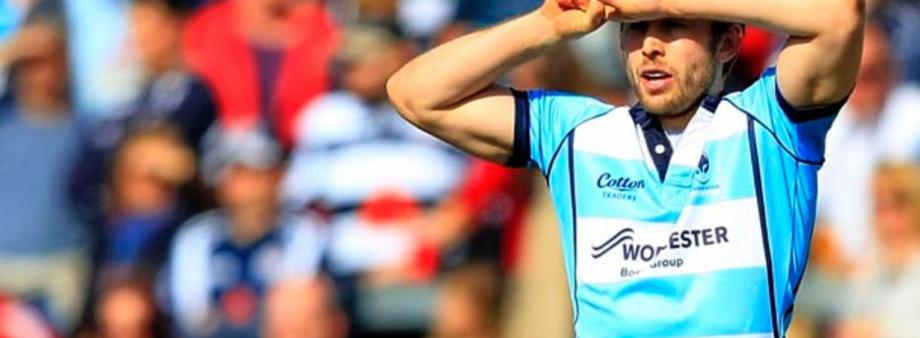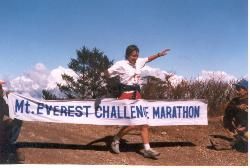
Ultra-marathon
By Dawn Kenwright
Starting With My Diabetes
At
the height of an International career, representing Wales at road,
cross-country and on the mountains, and also competing in marathons,
running was taking me all over the world. Suddenly in 1993 I was
diagnosed as having insulin dependent diabetes. This came as a
tremendous shock to me. There was no family history of diabetes, I was
extremely fit, and I was only in my thirties. Being a very active
person I was determined to remain so despite now being dependent on
insulin. My diabetes care team were very supportive but I still had to
learn through trial and error how to organise my diet, running and
insulin. And believe me, I had to learn quickly in order to
keep my place in the Welsh team. Within six weeks of starting on
insulin I was again selected to represent Wales, this time at the World
Mountain Running Championships in France.
Insulin Treatment
The
most effective insulin regime for me is to take short acting insulin 3
times a day before each meal and long acting insulin at the same time
each evening. I vary my insulin dosage according to my planned
exercise. So, for example, before a marathon, I reduce my short acting
insulin by half but I take the same amount of long acting insulin.
Sometimes I even increase the long acting insulin to give me enough
during an event. I have a high carbohydrate breakfast of porridge on
the morning of a marathon and high carbohydrate meals during the week
leading up to it. I occasionally experience hypoglycaemia later the
same day as an endurance event or even the next day, but have learnt to
prevent this by eating complex carbohydrate within 20 minutes of
finishing a race. For shorter events, my routine is quite different, as
I often increase my short acting insulin beforehand. The speed and
intensity of short races cause my blood sugars to rise rapidly, and
sometimes I finish with readings of over 20. To counter this, I take
extra short acting insulin immediately after completing the race to
bring my blood sugars down rapidly and prevent the risk of long term
damage. On the days when I do not run, my blood sugars are generally
much higher, and so I increase my insulins accordingly.
Trekking
Setting
myself challenges and goals has helped me to cope with having diabetes.
One of these was to return to high altitude running. In 1989, four
years before my diagnosis, I had trekked for 120 miles across Nepal,
from Kathmandu to Everest Base Camp. I then ran the highest marathon in
the world, starting at 17,500 feet at a temperature of –20C. I finished
over 5 hours later in temperatures of over 20C. I was first lady and
set a world record. It was a highlight of my life. After diagnosis, the
view of my diabetes care team was that I should forget the idea of any
such adventure in the future. But as time went on, and as I grew more
and more confident in my own diabetes management and control, I decided
to go back to the Himalayas. In 1995, I ran another marathon, this time
in the Indian Himalayas. I was delighted when I completed the marathon
and was first lady. Then in 1999, I decided to return to Everest and
attempt the Nepalese marathon again. Ten years on, and now with
diabetes, I had to learn how to prevent my insulin and meters from
freezing, how to do blood tests hygienically in temperatures varying
from arctic to tropical. I was really pleased not only to complete the
trek in, but also to finish the marathon, and amazingly win the ladies
race again.
Ultra Marathon
I
also took up ultra-distance running. In 1998, I won the Welsh Ladies
Ultra Marathon Championships, a distance of 40 miles, in 5 hours and 33
minutes. In 1999, I went to the Isle de Reunion, in the Indian Ocean,
for the Grand Raid. This is an ultra-distance event of 80 miles across
the entire island, crossing 3 volcanoes with over 29,000ft of ascent. I
became the first British woman ever to complete the race. It took me 36
hours with only short stops for insulin and food and blister treatment.
In 2001, I travelled to South Africa for the Comrades Marathon, a 55
mile race from Pietermaritzberg to Durban. Taking 8 hours 32 minutes, I
was the first British woman home, and received a Bob Rowan medal for my
achievement. In April 2004, I returned to South Africa to compete in
the Two Oceans Marathon, a 35 mile event from Cape Town and I achieved
a bronze medal standard.
Dealing With Hypos
Eighteen
months ago I started having a few severe night-time hypoglycaemic
attacks and was advised to change my insulin from Actrapid and
Insulatard to Novorapid and Lantus. The hypos did not improve, in fact
they became more frequent and sporadic. So I have recently changed
back to Insulatard while still continuing to use Novorapid. Hopefully
this change will make it possible for me to maintain my control and
avoid future hypos.
Living with diabetes has not always been easy but I now know that the only limitations are the ones you make yourself.


